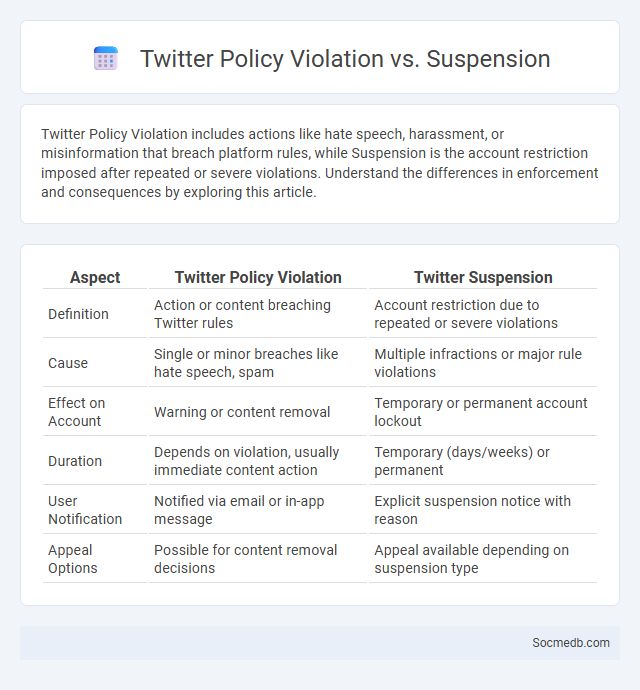
Photo illustration: Twitter Policy Violation vs Suspension
Twitter Policy Violation includes actions like hate speech, harassment, or misinformation that breach platform rules, while Suspension is the account restriction imposed after repeated or severe violations. Understand the differences in enforcement and consequences by exploring this article.
Table of Comparison
| Aspect | Twitter Policy Violation | Twitter Suspension |
|---|---|---|
| Definition | Action or content breaching Twitter rules | Account restriction due to repeated or severe violations |
| Cause | Single or minor breaches like hate speech, spam | Multiple infractions or major rule violations |
| Effect on Account | Warning or content removal | Temporary or permanent account lockout |
| Duration | Depends on violation, usually immediate content action | Temporary (days/weeks) or permanent |
| User Notification | Notified via email or in-app message | Explicit suspension notice with reason |
| Appeal Options | Possible for content removal decisions | Appeal available depending on suspension type |
Understanding Twitter Policy Violations
Twitter policy violations encompass behaviors such as hate speech, harassment, misinformation, and platform manipulation that breach the platform's guidelines designed to maintain a safe and trustworthy environment. Understanding these violations requires familiarity with Twitter's rules on harmful content, including the prohibition of threats, targeted abuse, and the spread of false information that can mislead or incite violence. Enforcement actions range from content removal and temporary account suspensions to permanent bans, emphasizing Twitter's commitment to upholding community standards and user safety.
Common Types of Twitter Violations
Twitter violations frequently include harassment, hate speech, and spreading misinformation, all of which undermine platform safety and user trust. Content that promotes violence, engages in spam, or involves impersonation also breaches Twitter's policies, leading to account suspensions or bans. Understanding these common violations is crucial for maintaining compliance and fostering a respectful online community.
Twitter’s Warning System Explained
Twitter's warning system flags tweets containing potentially harmful content such as misinformation, hate speech, or graphic violence to reduce the spread of damaging information. When a user posts questionable material, Twitter applies labels or reduces the tweet's visibility to alert others while preserving freedom of expression. This mechanism leverages machine learning algorithms and human moderation to balance safety, transparency, and user engagement effectively.
What Triggers a Twitter Account Suspension?
Twitter account suspension is triggered by violations such as repeated spammy behavior, abusive language, or harmful content that breaches community guidelines. Engaging in activities like fake accounts, platform manipulation, or posting sensitive media can also lead to suspension. Protect Your account by adhering to Twitter's rules and avoiding actions that might trigger automated enforcement systems.
Temporary vs Permanent Suspension on Twitter
Temporary suspension on Twitter restricts user access for set durations, typically due to policy violations such as spam or abusive behavior, allowing users to regain account access after the penalty period. Permanent suspension results in indefinite account deactivation, often reserved for severe infractions like hate speech, repeated violations, or threats to platform safety, preventing users from restoring their profiles or content. Twitter's moderation policies emphasize temporary suspensions for corrective actions while reserving permanent bans to uphold community standards and deter egregious misuse.
Twitter Policy Violation vs Account Suspension
Twitter policy violations occur when users breach community guidelines, such as posting harmful content, misinformation, or engaging in abusive behavior. Repeated or severe violations may lead to account suspension, restricting your access to tweeting, retweeting, or interacting on the platform. Understanding the distinction helps you manage your activity and avoid penalties affecting your Twitter presence.
Steps Twitter Takes Before Suspending an Account
Twitter implements a multi-step process before suspending an account, starting with automated detection of policy violations such as hate speech, misinformation, or spam. The platform typically issues warnings, temporary locks, or request for account verification to allow users an opportunity to address the issues. Suspension occurs only when repeated violations persist or the content poses significant risk to community safety and compliance with Twitter's policies.
How to Appeal a Twitter Suspension
To appeal a Twitter suspension, you need to visit Twitter's Help Center and submit an appeal form detailing why your account should be reinstated, providing clear evidence that you did not violate Twitter's rules. Twitter's review process typically takes a few days, and maintaining a respectful tone in your appeal increases the chances of success. Your prompt and accurate response to any follow-up questions from Twitter is essential to restoring access to your account quickly.
Preventing Policy Violations on Twitter
Preventing policy violations on Twitter involves deploying advanced machine learning algorithms that detect harmful content such as hate speech, misinformation, and spam in real-time. Twitter's automated systems, combined with human moderation teams, enforce community guidelines by flagging, removing, or restricting violating posts to maintain platform integrity. Regular updates to enforcement policies and transparency reports enhance accountability and user trust in Twitter's content moderation efforts.
Impact of Policy Violations and Suspensions on Users
Policy violations on social media platforms often lead to account suspensions or restrictions, significantly affecting user engagement and digital presence. These measures can disrupt Your ability to connect with audiences, reduce content visibility, and damage online reputation. Understanding platform rules and actively complying with community guidelines is essential to prevent negative impacts on Your social media experience.
 socmedb.com
socmedb.com